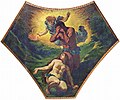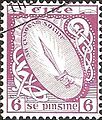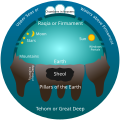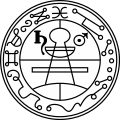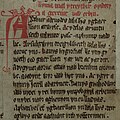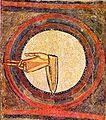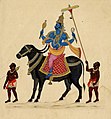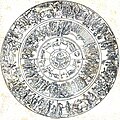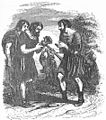Portail : Mythes
Portal maintenance status: (June 2018)
Please take care when editing, especially if using automated editing software. Learn how to update the maintenance information here. |
Wikipedia portal for content related to Myths Rubriques du portail Activités Culture Géographie Santé Histoire Mathématiques Nature Personnes Philosophie La religion Société Technologie Portail aléatoire
Le portail des mythes
 Billet belge de 1929 , représentant Cérès , Neptune et caducée
Billet belge de 1929 , représentant Cérès , Neptune et caducée
Le mythe est un genre folklorique constitué de récits qui jouent un rôle fondamental dans une société, comme les contes fondateurs ou les mythes d’origine . Étant donné que le terme mythe est largement utilisé pour impliquer qu’une histoire n’est pas objectivement vraie , l’identification d’un récit en tant que mythe peut être très controversée : de nombreux adeptes de religions considèrent les histoires de leur propre religion comme vraies , et s’opposent donc à ce que ces histoires soient caractérisées. comme des mythes, tout en considérant les histoires des autres religions comme étant des mythes. En tant que tel, certains chercheurs qualifient tous les récits religieux de mythespour des raisons pratiques, comme pour éviter de déprécier une tradition parce que les cultures s’interprètent différemment les unes par rapport aux autres. D’autres érudits évitent complètement d’utiliser le terme «mythe» et utilisent à la place des termes différents comme «histoire sacrée», «histoire sainte» ou simplement «histoire» pour éviter de donner des connotations péjoratives à tout récit sacré.
Les mythes sont souvent endossés par les autorités laïques et religieuses et sont étroitement liés à la religion ou à la spiritualité . De nombreuses sociétés regroupent leurs mythes, leurs légendes et leur histoire, considérant les mythes et les légendes comme de véritables récits de leur passé lointain. En particulier, les mythes de la création se déroulent à une époque primordiale où le monde n’avait pas atteint sa forme ultérieure. D’autres mythes expliquent comment les coutumes , les institutions et Les tabous d’une société ont été établis et sanctifiés. Il existe une relation complexe entre la récitation des mythes et la mise en œuvre des rituels .
Les personnages principaux des mythes sont généralement des non-humains, tels que des Dieux , des demi- Dieux et d’autres personnages surnaturels . Cependant, d’autres incluent également des humains, des animaux ou des combinaisons dans leur classification du mythe. Les histoires d’êtres humains ordinaires, bien que souvent de dirigeants d’un certain type, sont généralement contenues dans des légendes , par opposition aux mythes. Les mythes se distinguent parfois des légendes en ce sens que les mythes traitent de Dieux, n’ont généralement aucune base historique et se déroulent dans un monde du passé lointain, très différent de celui du présent. ( Article complet… )
Actualiser avec les nouvelles sélections ci-dessous (purge)
Article sélectionné – afficher un autre
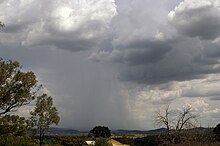 Les cumulonimbus sont impliqués dans les orages et peuvent produire de fortes pluies et de la grêle . On croyait que les démons pouvaient conduire ces nuages au-dessus des champs pour détruire les récoltes. Les démons pouvaient être déjoués par des hommes aux propriétés surnaturelles.
Les cumulonimbus sont impliqués dans les orages et peuvent produire de fortes pluies et de la grêle . On croyait que les démons pouvaient conduire ces nuages au-dessus des champs pour détruire les récoltes. Les démons pouvaient être déjoués par des hommes aux propriétés surnaturelles.
Un zduhać ( cyrillique : здухаћ, prononcé [zdǔxaːtɕ] ) et vetrovnjak (ветровњак, [ ʋetrǒʋɲaːk ]) dans la tradition serbe , et un homme-dragon dans les traditions bulgare , macédonienne et du sud de la Serbie, étaient des hommes soupçonnés d’avoir une capacité surnaturelle innée à protéger leur domaine, village ou région contre les conditions météorologiques destructrices, telles que les tempêtes , la grêle ou les pluies torrentielles. On croyait que les âmes de ces hommes pouvaient laisser leurs corps endormis, pour intercepter et combattre des êtres démoniaquesimaginés comme porteurs de mauvais temps. Après avoir vaincu les démons et emporté les nuages orageux qu’ils apportaient, les protecteurs retournaient dans leur corps et se réveillaient fatigués.
Les notions associées respectivement au zduhać, au vetrovnjak et à l’homme-dragon ne sont pas identiques. L’homme-dragon luttait contre des démons féminins appelés ala , qui provoquaient des nuages de grêle au-dessus des champs pour détruire les récoltes et consommaient la fertilité des champs. Les zduhaći (pluriel) d’une région se battaient généralement ensemble contre les zduhaći attaquants d’une autre région qui apportaient une tempête et des nuages de grêle au-dessus de leurs champs. Les zduhaći victorieux pillaient le rendement de tous les produits agricoles du territoire de leurs ennemis vaincus et l’emmenaient dans leur propre région. Le vetrovnjak, enregistré dans certaines parties de l’ouest de la Serbie, s’est battu contre un porteur de mauvais temps imaginé comme un oiseau noir. Les zduhaći sont enregistrés au Monténégro , dans l’est de l’ Herzégovine, une partie de la Bosnie et la région du Sandžak au sud-ouest de la Serbie. Les hommes-dragons sont enregistrés dans l’est de la Serbie, le Banat , l’ouest de la Bulgarie et la Macédoine . ( Article complet… )
| Liste des articles sélectionnés |
|---|
|
Le saviez-vous? – afficher différentes entrées
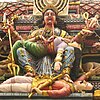
- … que des parents hindous tamouls dédient leurs enfants d’un mois à la déesse Periyachi (photo) , qui est représentée en train de déchirer le ventre d’une femme ?
![]()
- … que le dieu suprême des Bushmen d’Afrique australe est Cagn , un filou qui se métamorphose en Mante religieuse ?
![]()
![]()
![]()
![]()
![]()
![]()
![]()
![]()
![]()
Listes en vedette : Liste des noms de valkyrie dans la mythologie nordique![]()
Bons articles : phénomène de 2012 , guerre Æsir-Vanir , Ala (démon) , Ardhanarishvara , bataille de Barry , Bhikshatana , Chamunda , Chhinnamasta , épouses de Ganesha , Cú Chulainn , Dhumavati , Einherjar , Eir , Erebus , drapeau de fée , Fenrir , Gerðr , Hel (être) , Huginn et Muninn , Iðunn , Ila (hindouisme) ,![]()
![]()
![]()
![]()
![]()
![]()
![]()
![]()
![]()
![]()
![]()
![]()
![]()
![]()
![]()
![]()
![]()
![]()
![]()
![]()
![]()
![]() Kabandha , Kali , Kamadhenu , Kangiten , Keshi (démon) , Khandoba , Krishna , Kubera , thèmes LGBT dans la mythologie hindoue , Manasa , Mandodari , Matangi , Matrikas , Maya Sita , Mohini , Myrrha , Mythologie de Carnivàle , Naraka (Hindouisme) , Prester John , Prithu , Putana , Rati , Ratatoskr
Kabandha , Kali , Kamadhenu , Kangiten , Keshi (démon) , Khandoba , Krishna , Kubera , thèmes LGBT dans la mythologie hindoue , Manasa , Mandodari , Matangi , Matrikas , Maya Sita , Mohini , Myrrha , Mythologie de Carnivàle , Naraka (Hindouisme) , Prester John , Prithu , Putana , Rati , Ratatoskr![]()
![]()
![]()
![]()
![]()
![]()
![]()
![]()
![]()
![]()
![]()
![]()
![]()
![]()
![]()
![]()
![]()
![]()
![]()
![]()
![]()
![]() , Revanta , Satyavati , Sharabha , Shashthi , Shiva , Sif , Tara (Ramayana) , Troilus , Tuisto , Valhalla , Valkyrie , Vampire folklore par région , Varaha , Varahi , Veðrfölnir et aigle Zduhać
, Revanta , Satyavati , Sharabha , Shashthi , Shiva , Sif , Tara (Ramayana) , Troilus , Tuisto , Valhalla , Valkyrie , Vampire folklore par région , Varaha , Varahi , Veðrfölnir et aigle Zduhać![]()
![]()
![]()
![]()
![]()
![]()
![]()
![]()
![]()
![]()
![]()
![]()
![]()
![]()
![]()
![]()
… Contenu reconnu sur Wikipédia
Wikiversité
- Portail de la mythologie sur Wikiversity
Créature sélectionnée – en montrer une autre
 Un grand pingouin , qui peut être la source des descriptions du boobrie
Un grand pingouin , qui peut être la source des descriptions du boobrie
Le boobrie est une entité mythologique métamorphosée habitant les lochs de la côte ouest de l’Écosse. Il adopte couramment l’apparence d’un gigantesque oiseau aquatique ressemblant à un cormoran ou un grand plongeur nordique , mais il peut aussi se matérialiser sous la forme de diverses autres créatures mythologiques comme un taureau d’eau .
Entité généralement malveillante, le boobrie se nourrit généralement de bétail transporté sur des navires, mais il aime aussi les loutres, dont il consomme un nombre considérable. Dans sa manifestation en tant que cheval d’eau, la créature est capable de galoper au sommet des lochs comme si elle était sur un sol solide. Pendant les mois d’été, on le voit rarement comme un gros insecte, suçant le sang des chevaux. ( Article complet… )
| Liste des créatures sélectionnées |
|---|
|
Images générales
Voici des images de divers articles liés aux mythes sur Wikipedia.
-
![]()
Ballades de bravoure (1877) faisant partie de la mythologie arthurienne (du mythe )
-
![]()
The Shrine of the Three Kings in Cologne Cathedral (from List of mythological objects)
-
![]()
Hop-o’-My-Thumb stealing the Seven-league boots from the Ogre, by Gustave Doré (from List of mythological objects)
-
![]()
Hanuman fetches the herb-bearing mountain, in a print from the Ravi Varma Press, 1910’s (from List of mythological objects)
-
![]()
An angel (Camael) expelling Adam and Eve with a flaming sword (from List of mythological objects)
-
![]()
The Dispute of Minerva and Neptune (c. 1689 or 1706) by René-Antoine Houasse, depicting the founding myth of Athens (from National myth)
-
![]()
Fig trees often represent talismans with the udumbara (from List of mythological objects)
-
Several mythical creatures from Bilderbuch für Kinder (picture book for children) between 1790 and 1830, by Friedrich Justin Bertuch (from Legendary creature)
-
A 19th-century drawing of Sun Wukong featuring his staff (from List of mythological objects)
-
![]()
Claíomh Solais on an Ireland stamp printed in 1922 (from List of mythological objects)
-
![]()
Early Hebrew Conception of the Universe (from List of mythological objects)
-
![]()
Ancient Roman relief from the Cathedral of Maria Saal showing the infant twins Romulus and Remus being suckled by a she-wolf (from Comparative mythology)
-
![]()
Adams Bridge also called as Rama Setu (from List of mythological objects)
-
![]()
Voodoo doll with pins in it, Museum of Witchcraft (from List of mythological objects)
-
![]()
Lord Vishnu took the form of Beauty Mohini and distributed the Amrita (Ambrosia, Elixir) to Devas. When Rahu (snake dragon) tried to steal the Amrita, his head was cut off (from List of mythological objects)
-
![]()
Väinämöinen, the wise demigod and one of the significant characters of Finnish mythological 19th-century epic poetry, The Kalevala. (Väinämöinen’s Play, Robert Wilhelm Ekman, 1866) (from Myth)
-
![]()
Amenonuhoko (天沼矛 or 天之瓊矛 or 天瓊戈, “heavenly jeweled spear”) is the name given to the spear in Shinto used to raise the primordial land-mass, Onogoro-shima, from the sea (from List of mythological objects)
-
![]()
Artist’s impressions of the (unseen) Imperial Regalia of Japan (from List of mythological objects)
-
![]()
Fountain of Youth (from List of mythological objects)
-
![The ancient Roman poet Ovid, in his "The Metamorphoses," told the story of the nymph Io who was seduced by Jupiter, the king of the gods. When his wife Juno became jealous, Jupiter transformed Io into a heifer to protect her. This panel relates the second half of the story. In the upper left, Jupiter emerges from clouds to order Mercury to rescue Io. In the lower-left, Mercury guides his herd to the spot where Io is guarded by the hundred-eyed Argus. In the upper center, Mercury, disguised as a shepherd, lulls Argus to sleep and beheads him. Juno then takes Argus's eyes to ornament the tail feathers of her peacock and sends the Furies to pursue Io, who flees to the Nile River. At last, Jupiter prevails on his wife to cease tormenting the nymph, who, upon resuming her natural form, escapes to the forest and ultimately becomes the Egyptian goddess Isis]()
This panel by Bartolomeo di Giovanni relates the second half of the Metamorphoses. In the upper left, Jupiter emerges from clouds to order Mercury to rescue Io. (from Myth)
-
![]()
As is usual in bestiaries, the lynx in this late 13th-century English manuscript is shown urinating, the urine turning to the mythical stone Lyngurium (from List of mythological objects)
-
![]()
Surya gifts Yudhishthira the Akshayapatra (from List of mythological objects)
-
![]()
Erlang Shen (二郎神), or Erlang is a Chinese God with his spear (from List of mythological objects)
-
![]()
Surya on His Celestial Chariot (from List of mythological objects)
-
![]()
1929 Belgian banknote, depicting Ceres, Neptune and caduceus (from Myth)
-
![]()
Azoth, a universal medicine or universal solvent sought in alchemy. (Medieval legend) (from List of mythological objects)
-
![]()
The Celestial Chariot, Pushpaka Vimana from Ramayana (from List of mythological objects)
-
![]()
The third gift — an enormous hammer (1902) by Elmer Boyd Smith and the ring Draupnir is visible among other creations by the Sons of Ivaldi (from List of mythological objects)
-
![]()
Veronica holding her veil, Hans Memling, c. 1470 (from List of mythological objects)
-
![]()
Jason returns with Golden fleece (from List of mythological objects)
-
![]()
Jug from Lydian Treasure Usak (from List of mythological objects)
-
![]()
The Argo (c. 1500 – 1530), painting by Lorenzo Costa (from List of mythological objects)
-
![]()
Vishnu holding his famous sword Nandaka (from List of mythological objects)
-
![]()
Thor kicks Litr onto Baldr’s Hringhorni, illustration by Emil Doepler (ca. 1905) (from List of mythological objects)
-
![]()
Riding a Flying Carpet, an 1880 painting by Viktor Vasnetsov (from List of mythological objects)
-
![]()
The Stone of Destiny (Lia Fáil) at the Hill of Tara, once used as a coronation stone for the High Kings of Ireland (from List of mythological objects)
-
![]()
Golem and Loew (from List of mythological objects)
-
![]()
Greek God Kronos/Saturnus with sickle (from List of mythological objects)
-
![]()
Dietrich von Bern and Hildebrand fight against dragons (from List of mythological objects)
-
![]()
Fortune Wheel (from List of mythological objects)
-
![]()
Killing of Ravana Painting by Brahmstra of Arrow of Brahma (from List of mythological objects)
-
![]()
The fall of Icarus (from List of mythological objects)
-
![]()
Goetia seal of solomon (from List of mythological objects)
-
![]()
Myths and legends of Babylonia and Assyria (1916) (from Myth)
-
![]()
The Fall of the Titans (1596–98) by Cornelis Cornelisz van Haarlem (from Comparative mythology)
-
![]()
Snake and world egg of the inhabitants of Tyre (from List of mythological objects)
-
seven angels with seven trumpets (from List of mythological objects)
-
![]()
Opening lines of one of the Mabinogi myths from the Red Book of Hergest (written pre-13c, incorporating pre-Roman myths of Celtic gods):
Gereint vab Erbin. Arthur a deuodes dala llys yg Caerllion ar Wysc…
(Geraint the son of Erbin. Arthur was accustomed to hold his Court at Caerlleon upon Usk…) (from Myth) -
![]()
Ashwatthama uses Narayanastra (from List of mythological objects)
-
![]()
Sampo, a magical artifact of indeterminate type constructed by Ilmarinen that brought riches and good fortune to its holder, in the Finnish epic poetry Kalevala (The Forging of the Sampo, Joseph Alanen, 1911) (from List of mythological objects)
-
![]()
Shiva with his Trishula (from List of mythological objects)
-
![]()
The Deluge, frontispiece to Gustave Doré’s illustrated edition of the Bible. Based on the story of Noah’s Ark, this engraving shows humans and a tiger doomed by the flood futilely attempting to save their children and cubs. (from Comparative mythology)
-
![]()
Medieval bestiaries included mythical animals like the monoceros (above) alongside real animals like the bear. (from Legendary creature)
-
![]()
Aura, a field of luminous radiation surrounding a person or object (from List of mythological objects)
-
![]()
In classical mythology, the Minotaur was defeated by the hero Theseus. (from Legendary creature)
-
![]()
“The Fall of Man” by Lucas Cranach the Elder and the Tree of Knowledge is on the right (from List of mythological objects)
-
![]()
The Crown of Immortality, held by the allegorical figure Eterna (Eternity) (from List of mythological objects)
-
![]()
Symbolic power: a dragon in the Imperial City, Huế, Vietnam (from Legendary creature)
-
![]()
Heracles would use arrows dipped in the Hydra’s poisonous blood to kill other foes during his Labours, such as Stymphalian birds and the giant (from List of mythological objects)
-
![]()
Hand of God (from List of mythological objects)
-
![]()
Rectangular tablets passed down by the Hand of God in the 10th century Byzantine Leo Bible (from List of mythological objects)
-
![]()
Vishnu with his Panchajanya (from List of mythological objects)
-
![]()
Perillos being forced into the brazen bull that he built for Phalaris (from List of mythological objects)
-
![]()
“Tizona”, the sword attributed to El Cid, on exhibit in the Army Museum of Madrid (from List of mythological objects)
-
![]()
Houyi, the God of Archery (from List of mythological objects)
-
![]()
Ancient Sumerian cylinder seal impression showing the god Dumuzid being tortured in the Underworld by galla demons (from Comparative mythology)
-
![]()
Yama with his famous Yama Pasha (from List of mythological objects)
-
![]()
Achilles wearing his armor (from List of mythological objects)
-
![]()
Shield of Achilles (illustration) (from List of mythological objects)
-
![]()
Odysseus Overcome by Demodocus’ Song, by Francesco Hayez, 1813–15 (from Myth)
-
![]()
Golden cosmic egg Hiranyagarbha by Manaku (from List of mythological objects)
-
![]()
King Svafrlame Secures the Sword Tyrfing (from List of mythological objects)
-
![]()
The Honest Woodcutter, also known as Mercury and the Woodman and his famous Golden Axe (from List of mythological objects)
-
![]()
Thor wearing the magic belt Megingjörð (from List of mythological objects)
-
![]()
14th century Goryeo painting of Ksitigarbha holding a cintamani (from List of mythological objects)
-
![]()
Tissot Moses and Joshua in the Tabernacle (from List of mythological objects)
-
Image showing the sacred tree to the right of the temple, from Olaus Magnus’ Historia de Gentibus Septentrionalibus (1555). To the right of the tree is a depiction of a man being sacrificed in the spring (from List of mythological objects)
-
![]()
Prometheus (1868) by Gustave Moreau. In the mythos of Hesiodus and possibly Aeschylus (the Greek trilogy Prometheus Bound, Prometheus Unbound and Prometheus Pyrphoros), Prometheus is bound and tortured for giving fire to humanity. (from Myth)
-
![]()
Lichas bringing the garment of Nessus to Hercules (from List of mythological objects)
-
![]()
Pied piper (from List of mythological objects)
-
Jacob blesses Joseph and gives him the coat of many colors (from List of mythological objects)
-
![]()
Longinus with his famous Spear (from List of mythological objects)
-
![]()
Bhima fighting with his famous Gada (from List of mythological objects)
-
![]()
The Flying Dutchman (from List of mythological objects)
-
![]()
Arjuna fighting with his famous Bow (from List of mythological objects)
-
The famous sword of Excalibur painted by Howard Pyle (from List of mythological objects)
-
![]()
The Ash Yggdrasil by Friedrich Wilhelm Heine (from List of mythological objects)
-
![]()
The Giving of the Seven Bowls of Wrath / The First Six Plagues, Revelation 16:1–16. Matthias Gerung, c. 1531 (from List of mythological objects)
-
Giza pyramids (from List of mythological objects)
-
Holy Robe in Trier (from List of mythological objects)
-
![]()
Joan of Arc with her famous sword (from List of mythological objects)
Image 1Image 2Image 3Image 4Image 5Image 6Image 7Image 8Image 9Image 10Image 11Image 12Image 13Image 14Image 15Image 16Image 17Image 18Image 19Image 20Image 21Image 22Image 23Image 24Image 25Image 26Image 27Image 28Image 29Image 30Image 31Image 32Image 33Image 34Image 35Image 36Image 37Image 38Image 39Image 40Image 41Image 42Image 43Image 44Image 45Image 46Image 47Image 48Image 49Image 50Image 51Image 52Image 53Image 54Image 55Image 56Image 57Image 58Image 59Image 60Image 61Image 62Image 63Image 64Image 65Image 66Image 67Image 68Image 69Image 70Image 71Image 72Image 73Image 74Image 75Image 76Image 77Image 78Image 79Image 80Image 81Image 82Image 83Image 84Image 85Image 86Image 87Image 88Image 89Image 90Image 91Show all
Sous-catégories
![]() Mythes Mythes astronomiques Théorie du mythe du Christ Mythes de longévité Mythe malais des fantômes Mythes mésopotamiens Mythes d’origine
Mythes Mythes astronomiques Théorie du mythe du Christ Mythes de longévité Mythe malais des fantômes Mythes mésopotamiens Mythes d’origine
WikiProjets
![]()
- Wikiproject de la mythologie
- Wikiproject de la mythologie hindoue
- Groupe de travail sur la mythologie japonaise
Éditer
Choses que vous pouvez faire
- Aide au projet Articles manquants Mythe et folklore .
- Appliquez des talons de mythologie sur des articles de talon sur les “démons”, les “fantômes”, les “monstres”, la mythologie et “récupérez” ceux de Wikiproject Paranormal .
- Évaluation de l’aide sur Wikipedia:WikiProject Mythology/Assessment . Note : actuellement, fin octobre 2013, la plupart des articles non évalués sont dans le domaine de la mythologie chinoise.
- Placez la bannière du projet {{ WP Mythology }} sur les pages de discussion de tous les articles pertinents (si ce n’est déjà fait dans le cadre des sous-projets connus).
- Vérifiez les modifications récentes pour les améliorations récentes, le vandalisme et d’autres changements.
- Répondez aux demandes d’experts en mythologie : Catégorie : Articles de mythologie nécessitant l’attention d’un expert
- Développez des articles de mythologie comparative, tels que : Mythologie comparée , divinité de la mort , divinité lunaire , père du ciel , divinité solaire et dieu du tonnerre .
- Trier les similitudes dans les infos, et éventuellement fusionner les articles : Serpents dans la mythologie et Serpent (symbolisme) .
- Développez les articles des différentes divinités et entités. Les divinités importantes qui ont besoin d’attention sont Râ , Poséidon , Mercure et Minerve .
- Expliquez l’utilisation préférée de “mythe” et renommez ces articles mal nommés comme Mythologie de Final Fantasy X , Mythologie scientifique et Mythes de la tornade .
- Expliquez sur l’ article Fakelore quelles divinités (par exemple Belobog , Lado et Jofur ) sont considérées comme fakeloriques (inventées ou mal interprétées, et n’ont jamais été vénérées, historiquement).
- Récupérez les diverses informations sur la mythologie et les légendes à partir d’articles tels que : Liste des chiens fictifs et Liste des épées fictives .
- ET/OU aider les sous-projets de mythologie WikiProject mythologie hindoue , WikiProject mythologie japonaise , WikiProject mythologie coréenne et WikiProject Spiritualité .
- Photographies et photos demandées
Wikimédia associé
Les projets frères suivants de la Wikimedia Foundation fournissent plus d’informations sur ce sujet :
-
![]()
Référentiel multimédia gratuit Commons -
![]() Wikibooks
Wikibooks
Manuels et manuels gratuits -
![]() Wikidata
Wikidata
Base de connaissances gratuite -
![]() Wikinews
Wikinews
Actualités à contenu gratuit -
![]() Wikiquote
Wikiquote
Collection de citations -
![]() Wikisource
Wikisource
Bibliothèque de contenu gratuit -
![]() Wikiversité
Wikiversité
Outils d’apprentissage gratuits -
![]()
Dictionnaire Wiktionnaire et thésaurus
Découvrez Wikipédia à l’aide de portails
-
![Liste de tous les portails]() Liste de tous les portails
Liste de tous les portails -
![Le portail des arts]() Le portail des arts
Le portail des arts -
![Portail de biographie]() Portail de biographie
Portail de biographie -
![Portail de l'actualité]() Portail de l’actualité
Portail de l’actualité -
![Portail géographique]() Portail géographique
Portail géographique -
![Portail historique]() Portail historique
Portail historique -
![Portail des mathématiques]() Portail des mathématiques
Portail des mathématiques -
![Portail scientifique]() Portail scientifique
Portail scientifique -
![Portail de la société]() Portail de la société
Portail de la société -
![Portail technologique]() Portail technologique
Portail technologique -
![Portail aléatoire]() Portail aléatoire
Portail aléatoire -
![Portails WikiProject]() Portails WikiProject
Portails WikiProject





